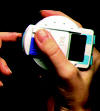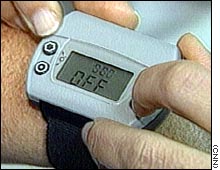Glucose Monitoring
Glucose Monitoring
There has been a lot of progress in research
to find  new
ways of letting diabetics test their glucose levels without having to place of
drop of blood onto a test strip on a glucose monitor (the "fingerstick"
method).
new
ways of letting diabetics test their glucose levels without having to place of
drop of blood onto a test strip on a glucose monitor (the "fingerstick"
method).
A non-invasive blood glucose monitor for adults with diabetes
was has been introduced in America. The GlucoWatch, developed by Cygnus
Inc., extracts glucose from skin cells rather than blood. A low-level electrical
current (0.3 mA/cm2) is applied to the area under the watch for
approximately 3 minutes. Glucose is detected and analysed, producing an
equivalent blood glucose value in 20 minutes. Since excessive sweat can interfere with the measurement, an alarm will sound
signifying the measurement was skipped. The GlucoWatch will also sound an alarm
if it detects dangerously low BG (blood-glucose level). Compared to the traditional "fingerstick"
method, the GlucoWatch is pretty slow and not quite as accurate (there was a
mean absolute error between the methods of 15.6% when tests were done in
November 1999). It is, however, far less painful and traumatic for the patient
and I'm sure it will be introduced in Britain eventually.
Since excessive sweat can interfere with the measurement, an alarm will sound
signifying the measurement was skipped. The GlucoWatch will also sound an alarm
if it detects dangerously low BG (blood-glucose level). Compared to the traditional "fingerstick"
method, the GlucoWatch is pretty slow and not quite as accurate (there was a
mean absolute error between the methods of 15.6% when tests were done in
November 1999). It is, however, far less painful and traumatic for the patient
and I'm sure it will be introduced in Britain eventually.
Another non-invasive method of glucose monitoring is being investigated by the Arnold Research Group at the University of Iowa. Their idea is to pass a beam of near infrared light through a vascular region of the body and then extract the glucose concentration from the resulting spectral information.